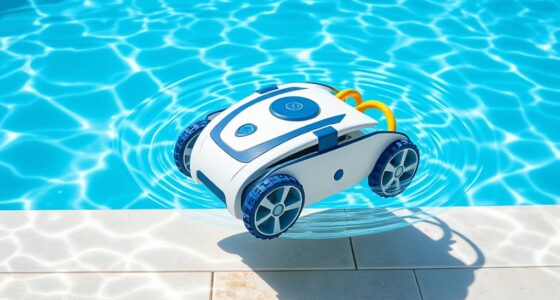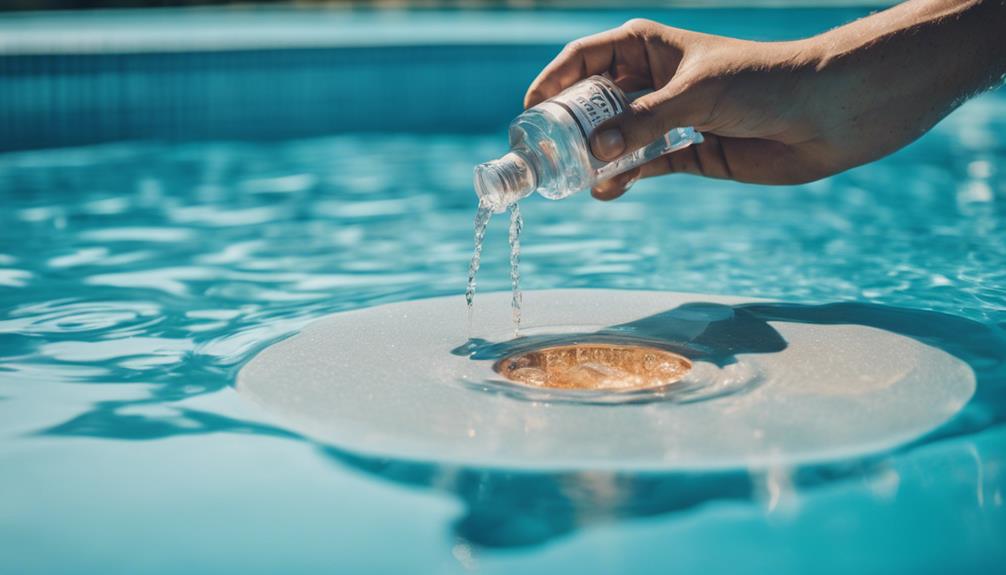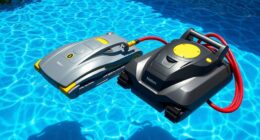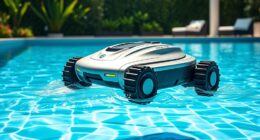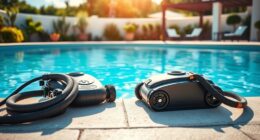Excited to make a splash this summer? Keep your pool sparkling with these essential tips! To start, make sure to skim the surface regularly to prevent debris buildup. Keep the skimmer basket clean to maintain pump efficiency. Consider using an automatic pool cleaner for convenience and to ensure cleanliness. Adjust your pump usage according to your pool size and needs. Save money on chemical maintenance by using bleach and baking soda. Don’t neglect brushing the walls and tiles to prevent algae growth. Shock the pool every 1-2 weeks to maintain proper chlorine levels. And don’t forget, clean filters are crucial! Want to learn more? Remember these tips!
Key Takeaways
- Regularly skim pool surface and clean skimmer basket to prevent debris buildup and maintain pump efficiency.
- Invest in an automatic pool cleaner for hands-free maintenance and thorough cleaning.
- Test and balance water regularly using test strips or liquid kits to ensure ideal water quality.
- Shock the pool every 1-2 weeks to restore chlorine levels and enhance water clarity.
- Regularly clean and backwash filters for maximum filtration efficiency and clean, safe pool water.
Skim Pool Surface Regularly
To maintain a clean and clear pool, regularly skim the pool surface to prevent debris buildup. Skimming is like giving your pool a daily embrace, keeping it happy and sparkling.
As you glide the skimmer across the water, you're not just removing leaves and bugs; you're also preventing those sneaky particles from clogging up your filters and pumps. Think of it as a little workout for your pool – the more you skim, the easier it's for your pool to breathe.
Plus, by skimming often, you're reducing the need for those extra cleaning sessions and chemical treatments that can be a real hassle.
Not only does skimming make your life easier, but it also does wonders for your pool's circulation and filtration efficiency. When the water is clear and debris-free, everything runs smoother.
Clean Skimmer Basket Often

Hey there, pool owner!
Keeping your skimmer basket clean is super important for your pool's health. By clearing out leaves and debris often, you help your pump do its job better, which means cleaner water for you to enjoy.
Don't forget this easy task; it's a small effort that goes a long way in keeping your pool in top shape!
Skimmer Basket Importance
Regularly cleaning the skimmer basket is essential for maintaining a well-functioning pool filtration system. Your skimmer basket plays a vital role in keeping your pool water clean and clear. By regularly clearing out debris from the skimmer basket, you prevent clogs that can disrupt the filtration system.
A clogged skimmer basket can lead to poor water circulation, which might even damage your pump over time. Plus, keeping the skimmer basket clean helps in maintaining a pristine pool surface by stopping debris from sinking to the bottom.
Neglecting this simple task could force you to use more chemicals to balance the water chemistry due to inefficient filtration. So, remember, a little effort in maintaining your skimmer basket goes a long way in ensuring top-notch skimming performance and a sparkling pool all summer long.
Keep that skimmer basket clean, and your pool will thank you for it!
Frequency of Cleaning
Don't overlook the importance of cleaning your skimmer basket frequently to maintain peak pool filtration efficiency. Your pool's skimmer basket plays an essential role in keeping your pool clean and functioning properly. Cleaning it at least once a week is necessary to prevent debris from clogging up your filtration system.
A clogged skimmer basket can disrupt water flow, making your pool pump work harder and less efficiently. By regularly clearing out leaves, bugs, and other debris from the skimmer basket, you're helping to guarantee proper water circulation throughout your pool.
Neglecting this simple task could result in costly repairs and an inefficient pool operation. So, make it a habit to clean your skimmer basket often as part of your pool maintenance routine. This small yet crucial step will contribute to keeping your pool sparkling and running smoothly all summer long.
Proper Skimmer Maintenance
Keeping your pool's skimmer basket cleanliness is essential for ideal water circulation and pump efficiency. Skimmer maintenance is one of those pool maintenance tips that often gets overlooked but plays a significant role in keeping your pool sparkling all summer long. By cleaning the skimmer basket regularly, you prevent debris from building up and guarantee that water circulates properly, keeping your pool water crystal clear.
A clean skimmer basket not only helps with water circulation but also improves the efficiency of your pool pump. When the skimmer basket is clogged, it can lead to poor water quality and even damage to your pump if left unattended. So, make it a habit to skim the basket frequently to maintain a clean and inviting pool environment.
Proper skimmer maintenance is a simple yet vital step in ensuring that your pool stays pristine throughout the summer. By taking care of your skimmer basket, you're also taking care of your pool's overall health and cleanliness.
Invest in Automatic Pool Cleaner

Want to spend less time scrubbing and more time enjoying your pool? Investing in a robot pool cleaner could be your new best friend.
These little machines zip around your pool, taking care of all the dirty work so you can kick back and relax.
Robot Pool Cleaners
Invest in an automatic pool cleaner for efficient hands-free pool maintenance. These robot pool cleaners are like little helpers for maintaining your pool throughout the summer. They use advanced technology to scrub, vacuum, and clean all the surfaces, walls, and steps of your pool with precision.
Imagine not having to manually clean every nook and cranny – these automatic cleaners do it for you! They save you time and effort by autonomously moving around the pool, leaving you with more time to enjoy a splash in the water.
Plus, they're energy-efficient and cost-effective in the long run, so it's a win-win situation. With an automatic pool cleaner, you can make sure that your pool remains sparkling clean consistently, making your swimming pool maintenance a breeze.
Benefits of Automation
Consider the convenience of incorporating an automatic pool cleaner into your pool maintenance routine for efficient and hassle-free cleaning. An automatic pool cleaner can be a game-changer in your pool care, saving you time and effort while ensuring ideal water quality.
These nifty devices are designed to navigate your pool, cleaning the walls, floor, and waterline with precision, leaving no spot untouched. By investing in automation like an automatic pool cleaner, you not only reduce the manual cleaning tasks but also enjoy a sparkling clean pool all summer long.
With the latest technological advancements, automatic pool cleaners are now more energy-efficient and cost-effective compared to traditional manual cleaning methods. So, say goodbye to the days of labor-intensive pool cleaning and hello to a more leisurely pool care routine.
Let the automatic pool cleaner do the hard work for you, while you sit back, relax, and enjoy a pristine pool without breaking a sweat.
Optimize Pool Pump Usage

To optimize the usage of your pool pump, make sure you run it for one cycle per day to maximize efficiency and save on electricity costs. Running your pump for about 8 hours a day is generally sufficient to keep your pool water clean and properly circulated.
By tailoring the pump runtime to your pool's specific requirements, you can potentially save $10 to $40 on your monthly electricity bill. Remember, knowing your pool size and pump horsepower is essential to ensuring your pump operates efficiently without wasting energy.
Additionally, using a clean and correctly sized filter is vital for maintaining water quality and extending the lifespan of your pump. So, by adjusting your pump's operation based on your pool's needs and keeping up with maintenance, you can enjoy a cost-effective way to care for your pool while reveling in clean and sparkling water all summer long.
Utilize Cost-Effective Chemicals

Let's talk about keeping your pool clean without breaking the bank. Using household items like bleach and baking soda can work wonders and save you some serious cash.
Plus, monitoring your water's chemical balance not only helps your wallet but also guarantees your pool stays crystal clear all season long.
Chemical Safety Tips
When utilizing cost-effective chemicals for pool maintenance, prioritize safety by following proper chemical handling guidelines. Using budget-friendly options like the BBB method with household products such as bleach and baking soda can help you save money without compromising on cleanliness.
It's important to understand chemical safety tips to guarantee a safe and enjoyable pool experience. Regularly test your pool water to maintain balanced chemistry and prevent the need for costly treatments or shocks.
Affordable Pool Maintenance
Consider incorporating household products like bleach and baking soda into your pool maintenance routine to save money on costly chemicals. By utilizing the BBB method – bleach, baking soda, and borax – you can effectively maintain your pool without breaking the bank. These everyday items can help you achieve that sparkling pool all summer long without the hefty price tag. Here's a simple breakdown to guide you:
| Benefit | Description |
|---|---|
| Cost-Effective | Reduce expenses on traditional pool chemicals while keeping your pool pristine |
| Easy to Use | Simply add the recommended amounts to your pool water for effective results |
| Environmentally Friendly | Household products are generally safer for the environment and your pool |
Incorporating these affordable alternatives not only helps in balancing your pool's water chemistry but also in maintaining the appropriate calcium hardness levels. So, go ahead and give these budget-friendly options a try to keep your pool in top shape throughout the summer!
Test and Balance Water Regularly

Maintain ideal water quality in your pool by regularly testing and balancing its chemical levels. Testing your pool water weekly is vital to make sure that it stays clean and safe for swimming.
Use test strips or liquid kits to check the chlorine, pH, alkalinity, and conditioner levels. By keeping these levels in check, you prevent algae growth and the need for expensive pool treatments. Balanced water chemistry not only saves you money but also saves you from the hassle of dealing with murky water.
Plus, a well-maintained pool is more inviting for a revitalizing swim on those hot summer days. So, make it a habit to consistently test and balance your pool water. It's a small effort that goes a long way in keeping your pool sparkling and ready for a dip at any time!
Brush Pool Walls and Tiles

To maintain a clean and inviting pool, make sure you regularly brush the pool walls and tiles. This simple task helps to prevent algae growth, bacteria buildup, and keeps your pool surfaces looking great all summer long.
Shock the Pool When Needed

Shocking your pool when needed is essential for eliminating contaminants and maintaining water clarity. Here are some must-know tips for effectively shocking your pool:
- Regular Shocking: It's recommended to shock your pool every 1-2 weeks to keep it clean and safe, especially after heavy usage.
- Restores Chlorine Levels: Shocking helps restore chlorine levels in the pool, ensuring proper sanitation and preventing bacteria growth.
- Enhances Water Clarity: By shocking the pool, you can keep the water crystal clear and inviting for an invigorating swim.
- Prevents Cloudy Water: Regularly shocking the pool helps prevent cloudy water, giving you that sparkling pool you love to plunge into.
Maintain Proper Filter Function

Regularly cleaning and backwashing pool filters is vital to guarantee maximum filtration efficiency. By maintaining proper filter function, you secure that debris and contaminants are effectively removed from your pool water, keeping it clean and safe for swimming.
Clean filters not only aid in maintaining sparkling water but also extend the lifespan of your filtration system, saving you from costly repairs down the line.
Schedule Professional Pool Maintenance

Maintain a sparkling pool all summer long by scheduling regular professional pool maintenance with Universal Pool Service. When you rely on their expertise, you're guaranteeing your pool stays clean, safe, and ready for you to enjoy at any time.
Here are four key benefits of investing in professional pool maintenance:
- Expert Care: Trust the licensed, bonded, and insured professionals at Universal Pool Service to provide high-quality pool maintenance tailored to your specific needs.
- Regular Skimming: Keep your pool clean and free of debris with routine skimming sessions that maintain the water's clarity and beauty.
- Vacuuming: Ensure a pristine pool bottom by including regular vacuuming in your maintenance schedule to remove any dirt or algae buildup.
- Chemical Balancing: Achieve the perfect water balance with professional chemical treatments that keep your pool water safe and crystal clear.
Frequently Asked Questions
How Do I Keep My Pool Sparkling?
To keep your pool sparkling, make sure to skim debris off the surface often and clean the skimmer basket. Test and balance chlorine, pH, alkalinity, and conditioner levels regularly. Use a quality test kit to monitor water parameters and avoid costly shocks.
Consider the BBB method and household products for chemical maintenance. Upgrade to a variable speed pump for better efficiency and lower electricity costs. These tips will keep your pool crystal clear and ready for summer fun!
What Chemical Makes Pool Sparkle?
Chlorine is the star player when it comes to making your pool sparkle. This chemical is a champ at zapping bacteria and algae, keeping your water clear and clean.
But don't forget about algaecides and pH balancers; they're like the sidekicks that help maintain that dazzling pool shine.
And when your pool needs a little extra love, shock treatments and clarifiers swoop in to save the day, getting rid of contaminants and filtering out debris for that picture-perfect sparkle!
How Do I Make My Pool Water Sparkle?
To make your pool water sparkle, keep up with regular water testing and balance those chemicals.
Skim the surface daily and vacuum weekly to keep it debris-free.
Don't forget to clean those filters and keep the water circulating smoothly.
Use chlorine and algaecide to fend off any pesky algae.
And remember, taking care of your pool equipment will also help maintain that sparkling pool all summer long.
How to Get Crystal Clear Swimming Pool Water?
To get crystal clear swimming pool water, start by testing and balancing the chemistry regularly.
Use a pool vacuum to suck up debris and dirt from the pool floor, giving it that sparkle.
Shock your pool weekly to zap away bacteria and algae.
Don't forget to clean those filters often for better water flow.
Keep that water circulating well and the pool surface clean to ward off any pesky algae growth.
Enjoy your sparkling pool all summer long!
Can These Cleaning Tips Also be Applied to Saltwater Swimming Pools?
When it comes to care for saltwater pool maintenance, it’s important to know that some cleaning tips for traditional pools can also be applied to saltwater swimming pools. Regularly skimming the surface, scrubbing the walls, and maintaining proper chemical levels are essential for keeping any pool clean and safe for swimming.
Conclusion
So there you have it, folks! With these 10 must-know cleaning tips, your pool will be sparkling all summer long.
Just imagine coming home to a crystal-clear oasis ready for an invigorating dip after a long day.
Trust me, your friends and family will be lining up to take a swim in your pristine pool.
Keep up with these simple maintenance tasks, and you'll be the envy of the neighborhood in no time.
Happy swimming!




